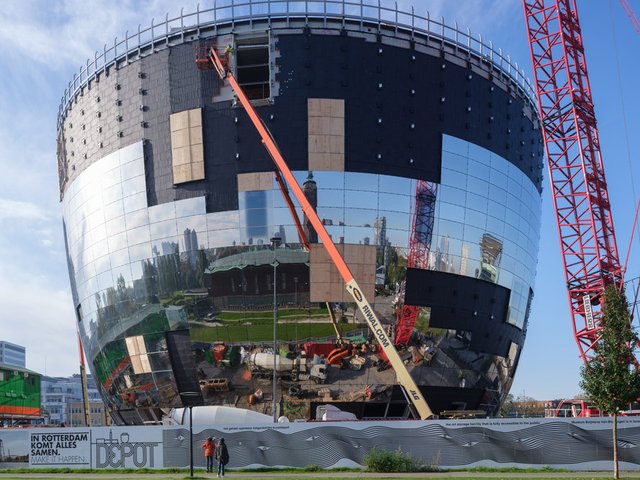The Fenix, a new museum in Rotterdam created to tell the story of migration through the prism of contemporary art, will open on 16 May 2025. The museum is sited in the Dutch city’s historic docklands in a former trans-shipment warehouse for the Holland America shipping line, which took more than 3 million migrants to and from the Netherlands in the late 19th and early 20th centuries.
The 1920s warehouse structure was renovated by the Rotterdam-based conservation and restoration practice Bureau Polderman, while Ma Yansong, the lead of the Beijing-based architectural firm MAD, created and integrated the eye-catching new stainless steel-clad double-helix Tornado structure at the heart of what is now a 16,000 sq. m structure.
The Fenix collection has been assembled since 2018 by Wim Pijbes, the director of the private Droom en Daad foundation and former general director of the Rijksmuseum. The Droom en Daad (dream and do) foundation—founded in 2016 to develop arts and culture institutions in the historic Dutch port city—initiated the Fenix project and funded the acquisition of the site, the museum’s new collection and a six-year building programme. The foundation’s other projects in Rotterdam include funding the move of the National Museum of Photography of the Netherlands to a nearby site at the Santos building, a former coffee warehouse, which is due to open later in 2025.
“We are an ambitious foundation,” Pijbes said of Droom en Daad at a launch event for local press and curators at the Dutch ambassador’s residence in London this week, describing its work as “venture philanthropy”. The foundation, he said, invests strategically: “We're preparing for a future in which we believe Rotterdam can become a defining European city of culture.” Pijbes referred to the diversity of Rotterdam—the museum is located in an area that hosted the first Chinatown in Europe—and quoted lines from a Rotterdam poet, Rien Vroegindeweij: “If everybody comes from somewhere else, then nobody is a stranger.”

The cavernous interior of Fenix, where a century-old reinforced concrete structure was restored as the first stage of creating the museum building © Wilbert Zuiderduin
“The story Fenix tells is linked to the city and its communities,” Anne Kremers, director of Fenix Museum since 2020, said at the London event. “That story is the world's. One of arrivals and departures and of constant change to face the future. From the departure for America on the great steamships, to the arrival of new communities from every part of the world, to build, to create, to learn.”
The launch exhibition, All Directions: Art That Moves You, will include works from the Fenix collection acquired in the past six years featuring historical artists —such as Honoré Daumier, Max Beckmann and Alfred Stieglitz—and contemporary creators, including Sophie Calle, Omar Victor Diop, Steve McQueen, Cornelia Parker, Gordon Parks, Yinka Shonibare and Danh Vō. The artists’ works will be shown alongside personal mementos, telling the migration stories of the people of Rotterdam.
Fenix will also present The Family of Migrants, a selection of the most striking photography on the subject of migration inspired by Edward Steichen’s celebrated 1955 exhibition Family of Man, at the Museum of Modern Art in New York. It will feature the work of 136 photographers from 55 countries including Fouad Elkoury, Dorothea Lange, Steve McCurry, Yasuhiro Ogawa and Emin Özmen.
“It's important that art can actually deal with some of the most important questions of our time,” the British artist Yinka Shonibare said in the museum’s announcement video, “and I'm glad that there is a museum that will be looking at the issue of migration.”
Fenix will include a large communal area, called Plein. “It is an indoor-outdoor space, a covered square on the grand scale," Kremers said. “The programming for this space will be shaped by and with the local community, perhaps one of the most diverse in Europe. From games to cooking and from markets to carnivals, from language lessons to a newspaper stand. Open all day, every day, free to all.”
Speaking in a launch video, Ma Yansong, said that the architects’ task was to “let the building tell by itself the stories of migration”. His Tornado structure features a double-helix wooden staircase, 550m long, with 336 steps. “The Tornado is a metaphor about the journey," he said. "As you walk up the staircase, the past connects with the future to bring you to the present. We need to be aware that our journey is not the only one. We are part of a big web of journeys. Once we realise that we are all interconnected, we will be able to embrace the different paths that make up our own.”




